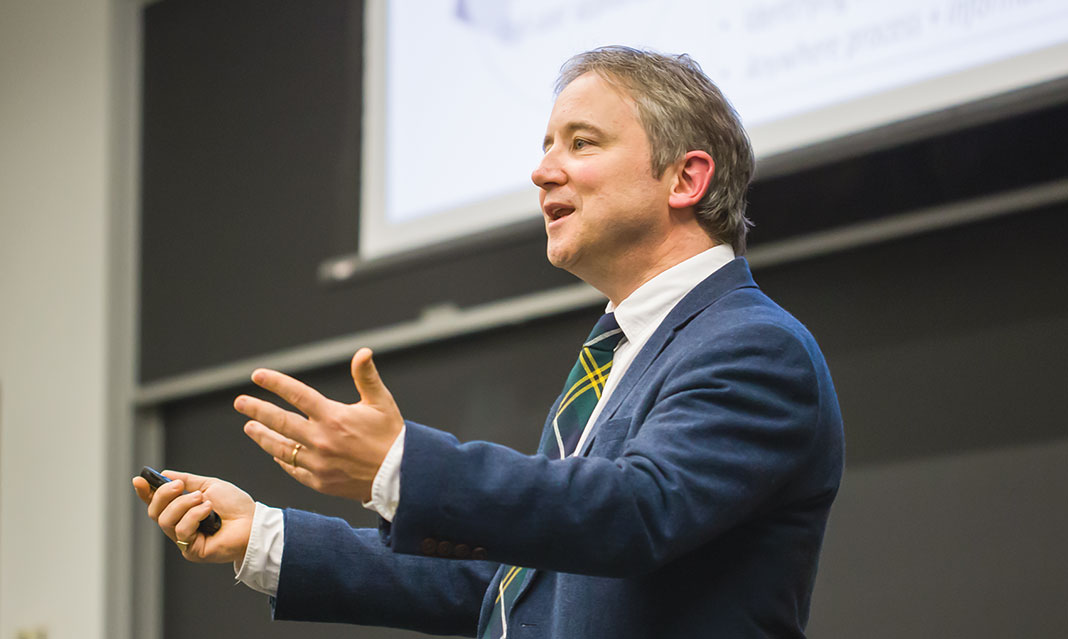Last Friday, the UTM Chemical and Physical Science Department hosted its third annual E. A Robinson Education Lecture featuring Professor Quintin Cutts from the School of Computing Science at the University of Glasgow. Cutts’ lecture titled “Bridging the Gulf: Computational Thinking for All” reflected his underlying belief that anyone can develop computational thinking. He elaborated that challenges in teaching computing can result in students struggling to grasp its concepts and went on to address these challenges by drawing on research within computing science (CS) education. Cutts’ success in driving the computational thinking that now underpins the Scottish school curriculum has earned him highly esteemed awards such as the Royal Society of Edinburg Inspiration Award in 2006, and the National Award for Teaching of Information & Computing Science in Higher Education in 2010.
Cutts began by asking the audience where computational thinking was within the spectrum. “One side of the spectrum is apps,” he declared. With its narrow purpose, apps can be used easily and “[through] intuition,” whereas the other side of the spectrum has programming language that requires deep knowledge and skills through understanding computer science, computing principles, and computational thinking.
Between the opposing sides, typical PCs such as Microsoft Office which require intuition and analysis occupy that gap. Cutts turned to the audience and asked, “Who here can use Word?” and was greeted by many raised hands. “But, have you ever used Word and became annoyed by all the pictures jumping around when you change something?”
According to Cutts, computational thinking drives economic growth. “If we can figure out how to automate information processes in businesses or identify them in science, computational thinking can model them and [information processes] are all over the place,” he acknowledged, emphasizing the importance of computing in the daily life.
However, there lies a “gulf of confusion” that divides “computer people” and “non-computer people.” Cutts attributes this gulf to explain why many people struggle with computer science or see it as an innate ability. Non-computing people cannot see that there has been a long learning path that the computing people have undergone and instead they often view computing people as “magicians.” Meanwhile, the “computer people” also often do not realize that they have been through the learning path.
Cutts continued to discuss the two main challenges in teaching computing: mindset and development issues. He had run some studies and experiments at Glasgow and found that students who are reminded on a regular basis to have a growing mindset or the notion that abilities are earned and not innate tend to score better than those who were not.
The second main challenge discusses teaching methods prevalent in computer science education that can prevent student from grasping concepts easily. One such example was the goal-directed problem solving, where students are set with large problems that will teach them through experience. However, Cutts notes that the studies conducted by other researchers found that this method results in a “cognitive overload,” where struggling to solve the problems “fills up [student’s] head and working memory” and in the end, there is “no space to learn anything.” Cutts also went on to discuss the importance of recognizing the subject’s stepwise nature and the ability to read codes before writing.
Cutts elaborated on how he addressed these challenges by describing his “uncertain path to influence national education bodies”. It began in 2005 when computer science was facing an enrolment crisis. In an attempt to “spic[e] up computing class,” Cutts created engaging classroom workshops which revealed to the students how easy it was to understand computer science. From then, Cutts has challenged the Scottish computer science education with the aim to improve the curriculum and engage students.
In 2013, he executed “Plan C,” professional training for teachers in Scotland and networking in computing. He recalled how a teacher approached him following the training and said, “It’s just amazing that [students now can] come up with their own programs and are more open to intelligent talk with [teachers].”
“We framed three key parts into the Scottish [computer science] Curriculum in 2-15 Broad General Education,” Cutts explained. “Understanding the world through computational thinking, understanding and analysing computing technology, and finally designing, building and testing computing solution.”
Computer science education is at “an exciting point” where it is starting to become “mandatory for all,” Cutts said. “Although we know a lot about teaching, not much of the research gets into practice but research and practice to develop high quality curricula and identify best pedagogical practices are still ongoing.”



